While there had been a few inconsistent and gimmicky One-Turn Kill decks in the game before that point, the GX era saw the rise of countless decks that were able to easily deal 8000 or more damage in a single turn. Before we get too far into what those decks were, however, let's turn our attention toward the first major meta deck of the period.
2005
The format that existed after the October 2005 Forbidden and Limited List, which ended Goat Format, was not a radical departure from the other post-Forbidden List Formats, but it did plant the seeds of the new era. With Black Luster Soldier - Envoy of the Beginning Forbidden and Thousand-Eyes Restrict, Tsukuyomi, Metamorphosis, and Scapegoat all Limited, the old Goat strategy was no longer competitively viable. This did not mean, however, that Chaos decks fell out of the meta entirely. They ended up taking on new forms, utilizing Chaos Sorcerer as a replacement for Black Luster Soldier.
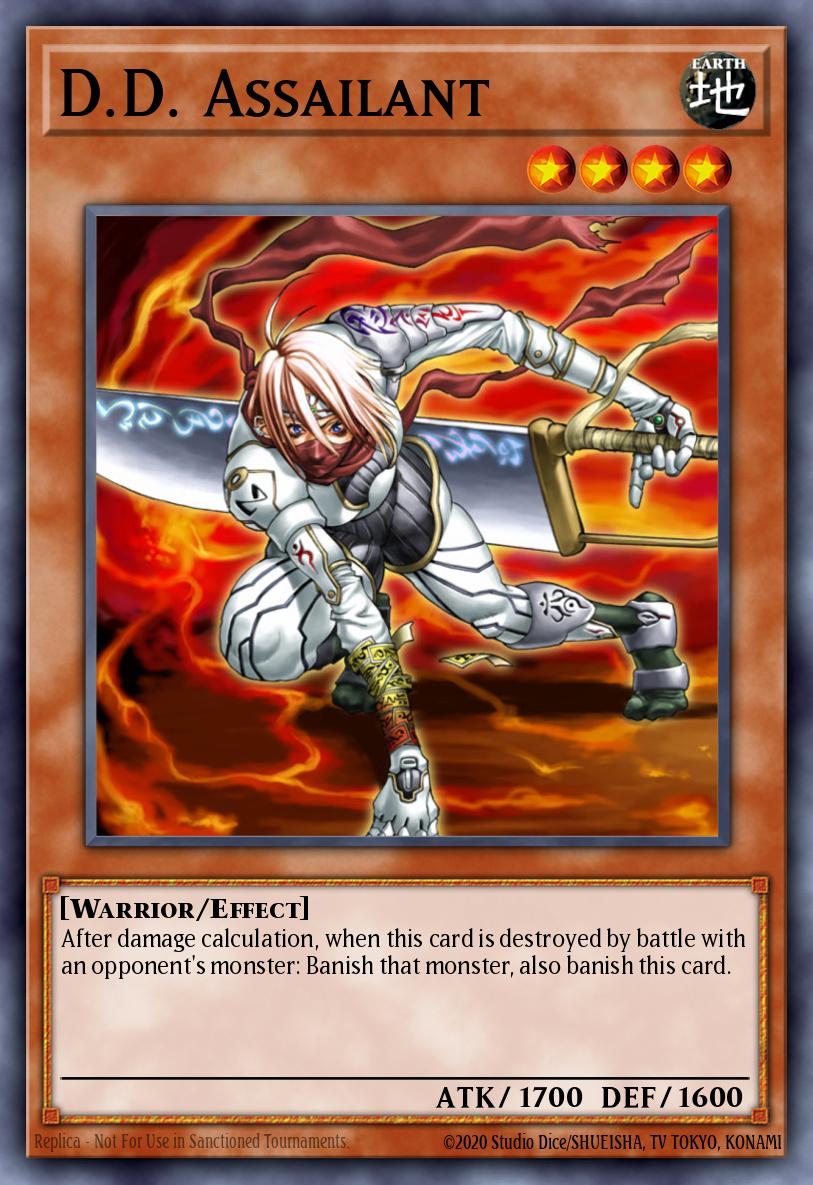 D.D. Assailant
D.D. AssailantThe most common Chaos variant that cropped up in this format was Cookie Cutter Warrior Toolbox. This deck transitioned away from emphasizing one-of tech cards and instead moved toward running 2-3 copies of key cards to make them easier to see in an average game. One of the most important of these cards was Spirit Reaper. Spirit Reaper had seen varying usage in the meta since its introduction back in 2003, and in 2005, the advantages of being unkillable by battle while also allowing minor hand control made Spirit Reaper one of the most prominent staple cards of the format. Another major staple card was Cyber Dragon, which made going second more viable and allowed players to establish multiple threats on the board in one turn. Battle traps also started to see much heavier usage during this format. While Sakuretsu Armor saw some use during Goat Format, it was usually as a one-of tech or a Side Deck card. As the October 2005 format continued, the prevalence of single monster destruction grew and grew with Sakuretsu Armor becoming a near staple at 3 in almost all topping decks with cards such as Smashing Ground and Widespread Ruin also starting to catch on. This emphasis on 1 for 1 removal interactions would go on to define the format and were one of the biggest reasons why the Warrior Toolbox strategy was so prominent amongst Chaos decks at the time. The Warrior Toolbox consisted of D.D. Warrior Lady, D.D. Assailant, Don Zaloog, Exiled Force, and sometimes D.D. Survivor and Mystic Swordsman LV2 as well. These cards were all searchable using Reinforcement of the Army, making them very consistently accessible. The emphasis on the D.D. monsters, especially D.D. Assailant which was most often run at 2 or 3 copies, was very in line with the focus on trading card advantage with an opponent.
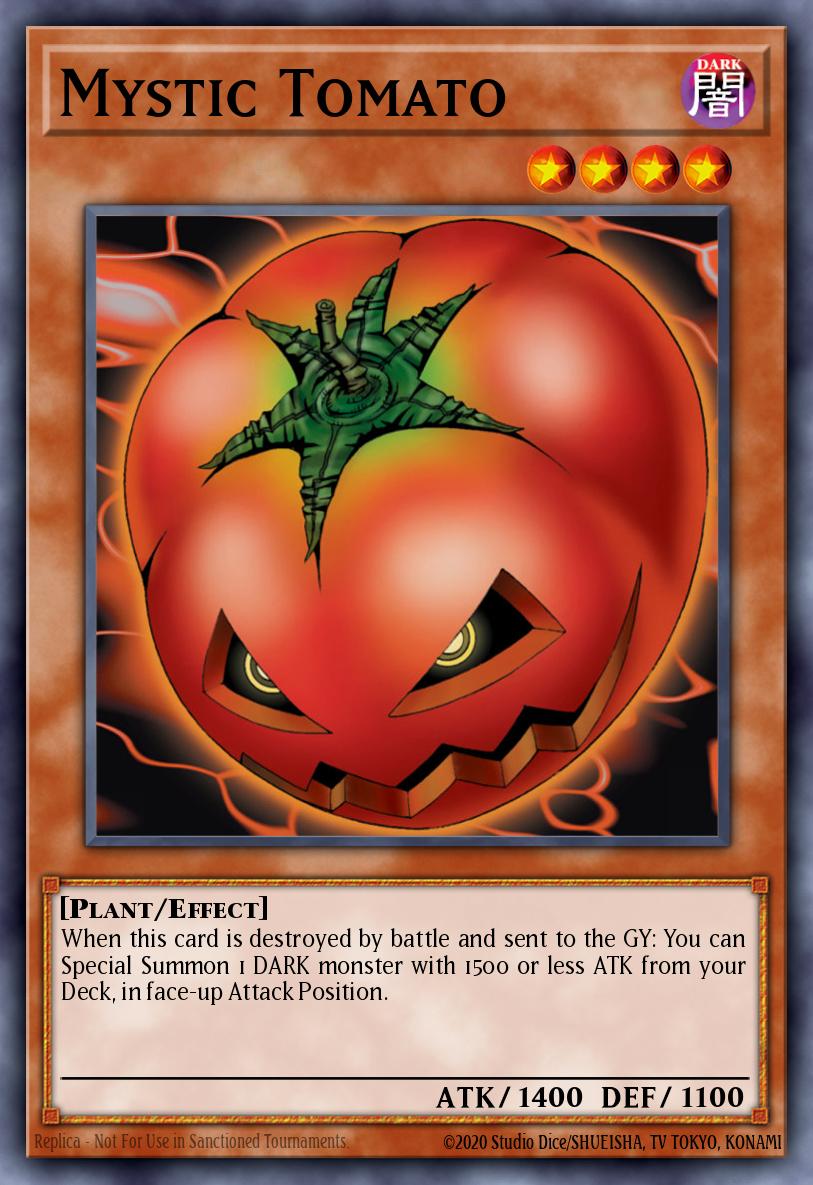 Mystic Tomato
Mystic TomatoAnother variant of the Cookie Cutter Warrior Toolbox deck also saw relatively prominent results in this format: Tomato Control. The deck was largely the same as the standard Cookie Cutter Warrior Toolbox, but it focused on utilizing Mystic Tomato in order to more consistently get power cards such as Spirit Reaper or Don Zaloog out faster, but also gave the deck much more consistent access to cards such as Sangan and Newdoria who were some of the more prominent floaters during this format. The deck also very often took advantage of an Apprentice Magician engine. This engine consisted of 3 Apprentice Magician and 2-3 Old Vindictive Magician. The overall goal of the engine was to maintain field advantage while also giving the option of either removing a monster with Old Vindictive Magician or gaining a Spell card back with Magician of Faith.
Another deck that saw play in the fall of 2005 was Bazoo Return. This deck was largely the same as the other major decks of the format, utilizing the Warrior engine to give a variety of options to the player, but used Bazoo the Soul Eater as a meta call. The reason behind this was that a fully powered up Bazoo would reach 2500 ATK which beat the other go-to high attack cards in the format such as Cyber Dragon, Chaos Sorcerer, and the Monarch monsters.
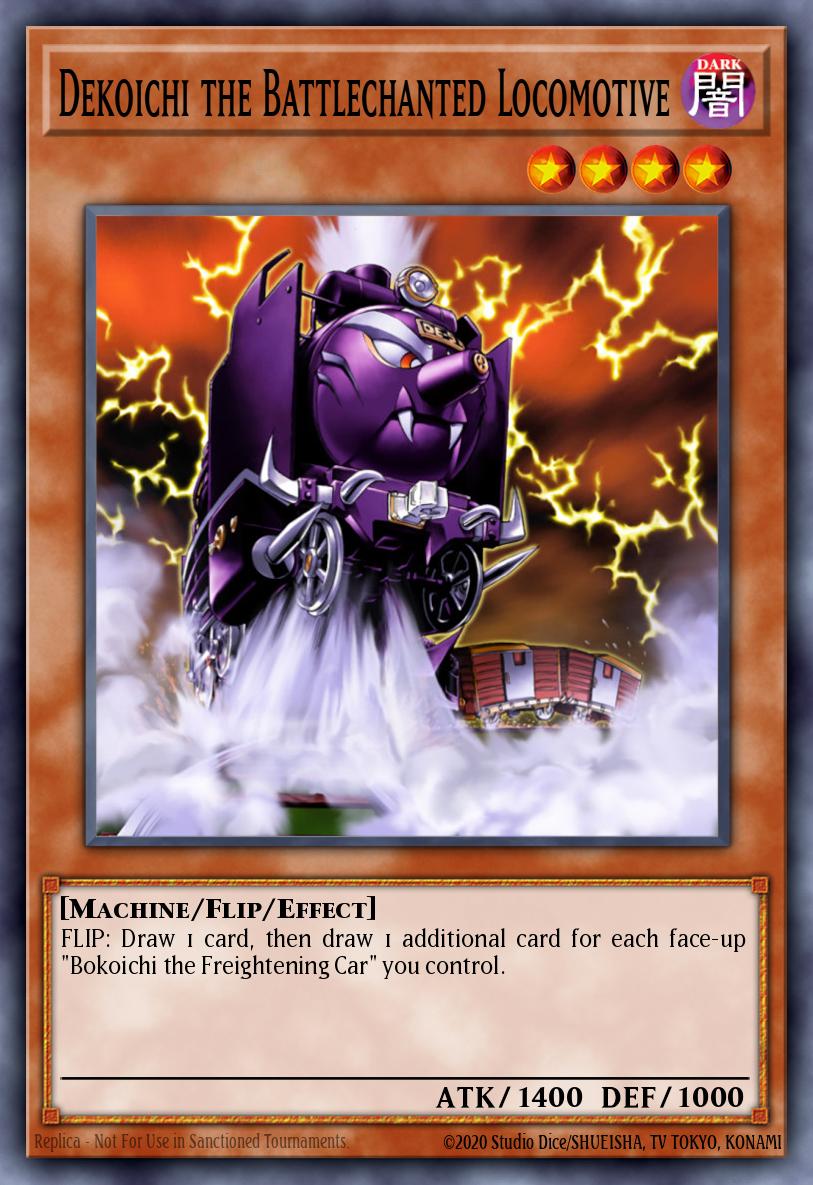 Dekoichi
DekoichiThe final deck of this format were Monarchs. Monarchs were released one at a time throughout 2004 and 2005, but they had never seen very widespread play outside of Mobius being a relatively common side deck choice during Goat Format due to its ability to clear out multiple face-down Spells and Traps. The advent of the new format, however, made the more dedicated Monarch decks see a small uptick in popularity. These decks focused almost entirely on Mobius and Zaborg, although Zaborg would not yet gain the popularity it would later enjoy. The strategy behind the deck was to focus using as many battle traps and destruction cards as possible in order to protect the deck's various advantage generating Flip Effect monsters, the most prominent of which being Dekoichi the Battlechanted Locomotive and Magical Merchant. Both of these cards, when flipped, would net their controller card advantage making them extremely versatile options. They also had the benefit of allowing their controller to not lose card advantage even if they were destroyed.
A common theme between all of these decks is that they shared a large number of common staples between them. However, unlike in prior formats where most decks employed the same basic strategies, the decks in the October 2005 format often employed very different play styles using these same cards. Overall this variance in playstyles would begin to give way into the more diverse metagame that would be seen going forward.
2006
The beginning of 2006 served as a continuation of the October 2005 Format, with the top decks still centering around mostly the same staple cards and with Chaos Warrior Toolbox decks staying on top of the meta. One of the big changes, however, was the trend towards heavier and heavier trap lineups. While certain decks, most notably Monarchs, had been maxing out on Sakuretsu Armor and running Widespread Ruin since late 2005, the tournaments in early 2006 began to see this trend spread out to the larger pool of decks. The format would further change with the introduction of Treeborn Frog in February of 2006 in the Shadow of Infinity booster set. This was able to operate as extremely persistent tribute fodder, therefore making Monarchs significantly easier to summon. This caused a shift in the meta towards main decked Monarchs being far more popular due to how much easier they became to summon.
It was during the rise in popularity of Monarchs that the decks started to move more towards Zaborg as the archetypal Monarch instead of Mobius. As Zaborg could destroy a monster on summon, he fit in much better with the increasingly destruction based meta that had been building since October of 2005. However, despite the newly increased popularity of Monarchs, the Cookie cutter Chaos Warrior Toolbox decks still reigned supreme.
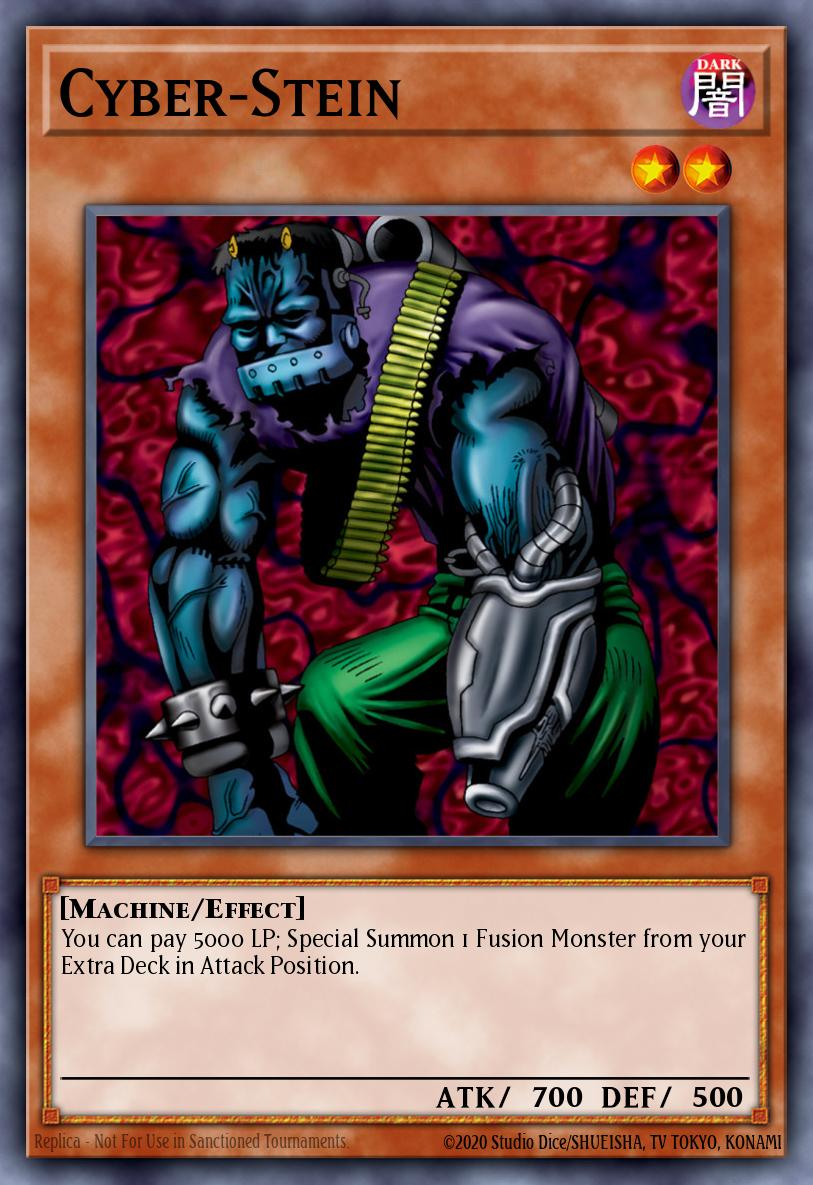 Cyber-Stein
Cyber-SteinThis early 2006 format also saw the introduction of a deck that would shape the meta going forward: Stein OTK. Cyber-Stein was originally a prize card, meaning that it was prohibitively difficult for most players to get. However, the card was reprinted as a Rare in Dark Beginning 2 in early 2005. The prevalence of Metamorphosis in the 2005 meta, however, made Cyber-Stein relatively superfluous as many of the most useful Fusion Monsters available at the time could be summoned at a much lower cost than they could with Cyber-Stein. The Limiting of Metamorphosis in October of 2005 would begin to pave the way for Cyber-Stein to enter the meta. The first iterations of the deck were focused around the Stein OTK combo. This combo focused on using Cyber-Stein to summon out Cyber Twin Dragon or Cyber End Dragon and then equipping it with Megamorph to OTK the opponent.
The format would shift away from Warriors with the April 2006 Forbidden List. This list made some significant shake-ups to the meta, most notably a Limit to D.D. Assailant, the core monster in Warrior Toolbox decks. The newly introduced Treeborn Frog and Pot of Avarice would also see themselves get Limited. Treeborn Frog had already rapidly proven itself as a staple for summoning out Monarch monsters while Pot of Avarice had become extremely easy to exploit as an effective Pot of Greed due to the ease with which monsters could be loaded into the Graveyard using Magical Merchant. Up to this point, Magical Merchant had grown to be a very common staple in a large portion of decks of the format due to both its ability to generate advantage on flipping while also making Pot of Avarice almost instantly usable.
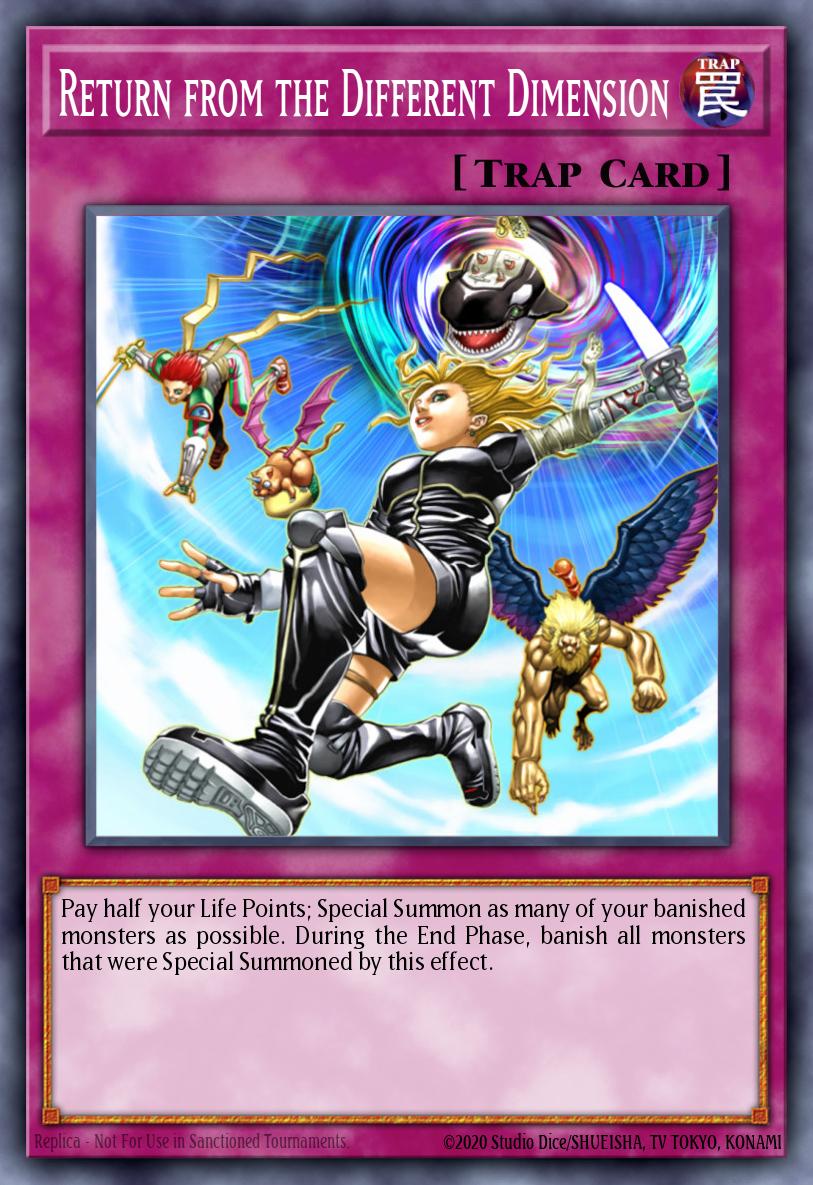 Return from the Different Dimension
Return from the Different DimensionIn the wake of this new List, the meta wouldn't shift radically, but the top decks would start to move away from using the Warrior Engine. In its place, top decks started to run more dedicated Chaos builds as well as introducing a new key card that would define the top deck of this format: Return From the Different Dimension. This card was able to be used in tandem with 3 copies of Chaos Sorcerer which could fill the banished zone, allowing a well-timed Return From the Different Dimension to completely flood the field and finish and opponent off out of nowhere. The new variant of Chaos, dubbed Chaos Return, would almost immediately make an impact on the format by winning the first Shonen Jump Championship after the April Forbidden List went into effect. The deck would go on to dominate the format, taking over the new top form of Chaos. For the most part the deck was very similar to Cookie Cutter Chaos Warrior Toolbox from the prior format with some minor adjustments. The first of these was the introduction of a new core Monarch monster to the meta. While Mobius had been the main monarch before the April Forbidden List, afterwards a somewhat lesser used Monarch shot into the spotlight: Zaborg the Thunder Monarch. Zaborg saw a spike in prominence for a variety of reasons. First of all, the April list had brought Mirror Force back into the game. This made the emphasis on running an extremely high count of battle traps less important as Mirror Force could do the same job as several of the weaker traps, making the backrow removal Mobius offered less crucial. Chaos Sorcerer's uptick in usage also made monster removal much more important while also making Light monsters to summon him with more in demand. These factors together led to the rise in prominence of Zaborg as the new key Monarch monster. Unlike Mobius, which saw use in more dedicated Monarch decks and mostly side deck usage outside of that, Zaborg would see usage at 1 or 2 copies in the main deck of almost every prominent meta deck of this format.
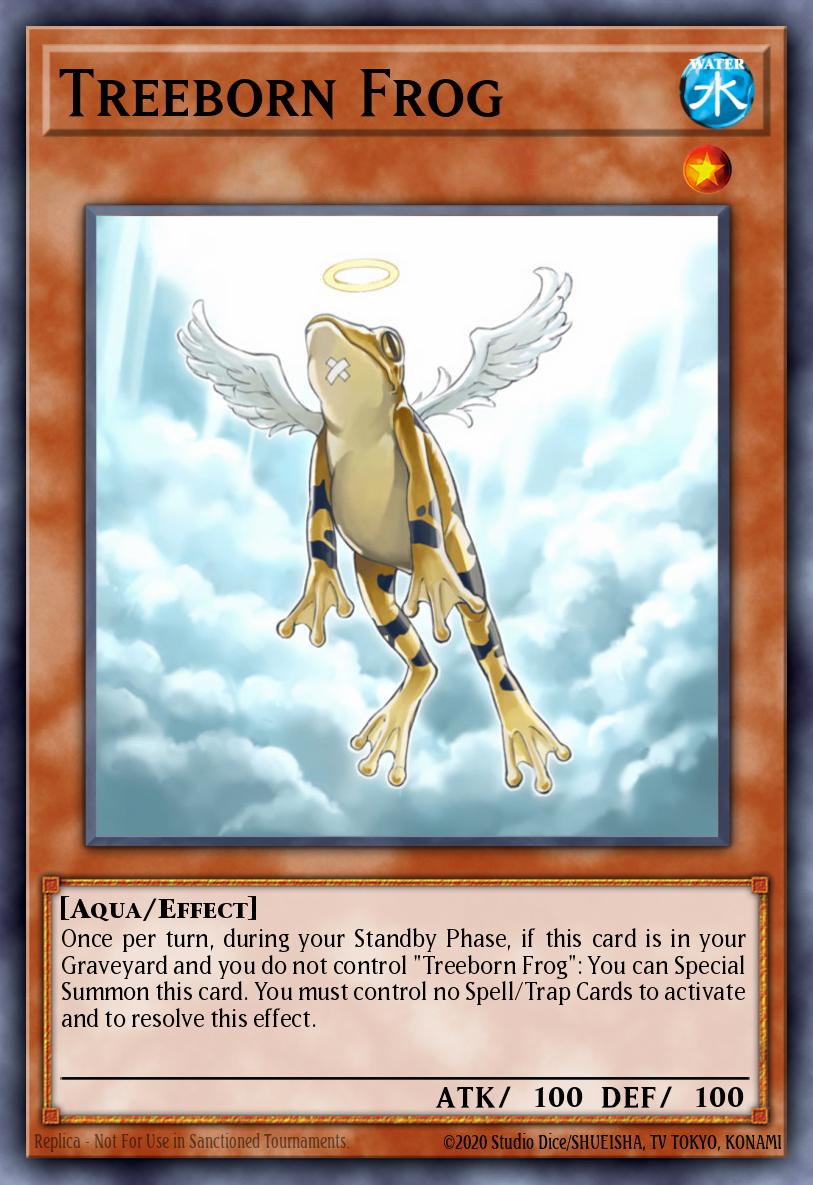 Treeborn Frog
Treeborn FrogSome further shifts in the staple pool also occurred during the new April 2006 Format. The first of these was the continuing increased usage of Cyber Dragon. While Cyber Dragon had seen continuous use in almost all major meta decks since the end of Goat Format, he had commonly been run only at 2 copies. However, with the much more focused nature of Chaos Return, Cyber Dragon started to see very common usage at 3 copies. Another card that started to see more mainstream use during this format was Dekoichi the Battlechanted Locomotive. This card had definitely seen use in Monarch decks and in various Chaos decks before the April Forbidden List, but the shift towards getting out Chaos Sorcerer as fast as possible led to many lists starting to run Dekoichi at 3 copies. He was very useful as he would both serve as a Dark target for summoning Chaos Sorcerer while also making sure that when he was destroyed his controller wouldn't lose any card advantage.
The other major deck of this format was Monarch Control. This deck was a natural evolution of the Monarch decks that had seen some success in the previous format, focusing on the same types of strategies. The deck also was very much a variant of Chaos, as the widespread adoption of Zaborg in standard Chaos Return decks meant that the core difference was often the focus on tribute summoning in Monarchs versus summoning Chaos Sorcerer in Chaos Return. The new iteration of the deck still relied heavily on using Flip Effect monsters to manage its resources while using both Treeborn Frog and Spirit Reaper to maintain board presence and tribute fodder. One of the key new techs that Monarchs started to adopt during this period was Soul Exchange. While Soul Exchange had been around since the beginning of the game, being released in Starter Deck Yugi, it had never really seen much competitive usage up to this point. However, the newly found emphasis on monster removal and a need for easy tribute fodder to summon out Zaborg and Mobius led to Soul Exchange gaining some traction in Monarch decks. It didn't, however, see the widespread usage in Monarchs that it would later. This was largely because Monarchs at this point were still largely a Chaos variant and therefore didn't need to focus as heavily on getting Monarch monsters out as fast and as often as possible when Chaos Sorcerer was a generally more viable removal option.
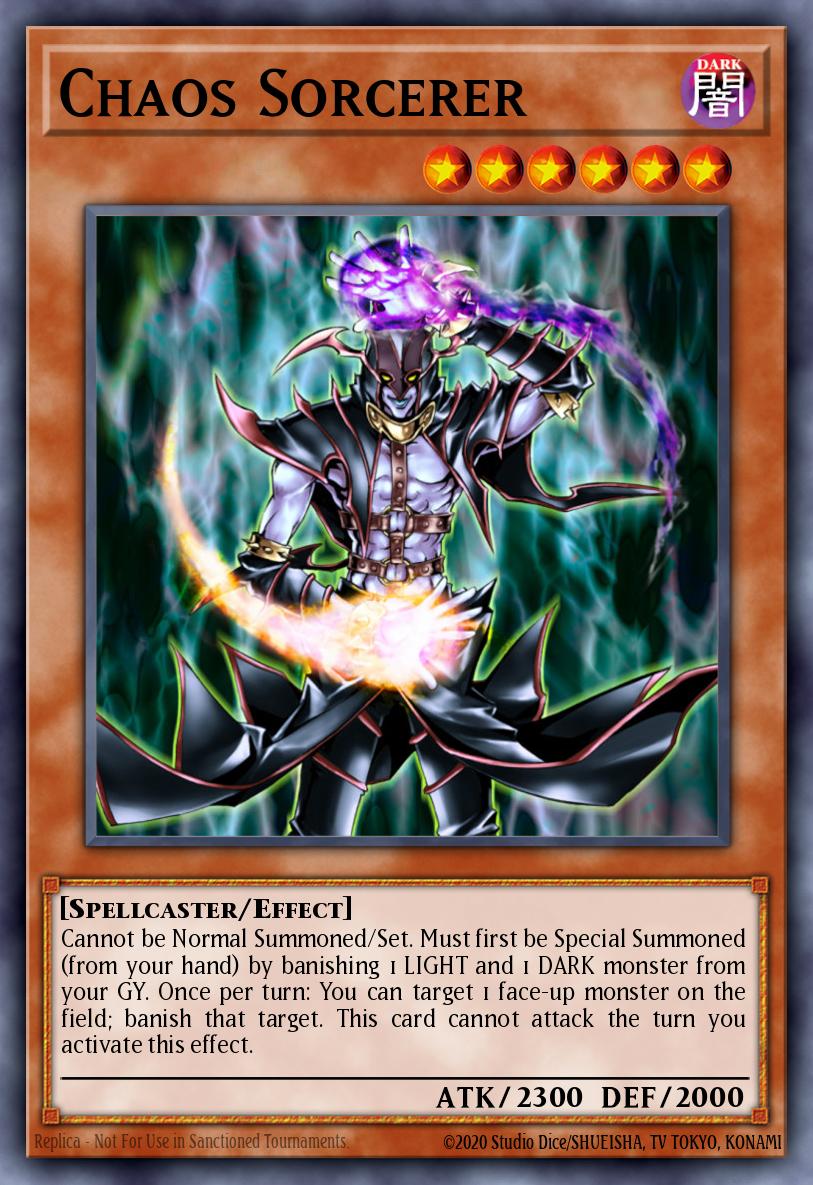 Chaos Sorcerer
Chaos SorcererAlong with these two decks, one other deck managed to stay on as a somewhat relevant force in the meta: Stein OTK. While Stein OTK had been lurking in the background of the meta since early on in 2006 and even in late 2005, the dedicated OTK variant of the deck had never really caught on in the meta. However, the newfound popularity of Zaborg combined with the use of an older OTK enabler from back in the Magical Scientist days brought the deck back. This older card was Last Will. Last Will allowed for a Zaborg and Cyber-Stein OTK combo. The combo required the player to have Last Will and a Zaborg with tribute fodder for it. The Zaborg would be tribute summoned, clearing out the opponent's monster and then Last Will would be activated. Seeing as a monster was sent to the Graveyard to Tribute Summon Zaborg, Last Will could summon out any 1500 or less ATK monster from the deck, namely Cyber-Stein. Cyber-Stein would then summon Cyber Twin Dragon which, together with Zaborg could direct attack an opponent for exactly 8000 points of damage. This combo would really start to catch on in June of 2006 during Nationals season. Most notably, Calvin Tsang would maindeck this combo in his Chaos Return deck, winning him the Canadian Nationals. What was perhaps the most powerful part of this combo was that it only required two cards , a single Cyber-Stein and a single Last Will, to be run to enable it. This easy access to a devastating and easily game-winning combo made it a near staple in almost every top 8 deck for the rest of the format. All decks would either be main-decking the cards or side-decking them depending on their matchup as the combo, while powerful, was very susceptible to any kind of burn or aggressive beatdown due to the extremely high Life Point cost of Cyber-Stein.
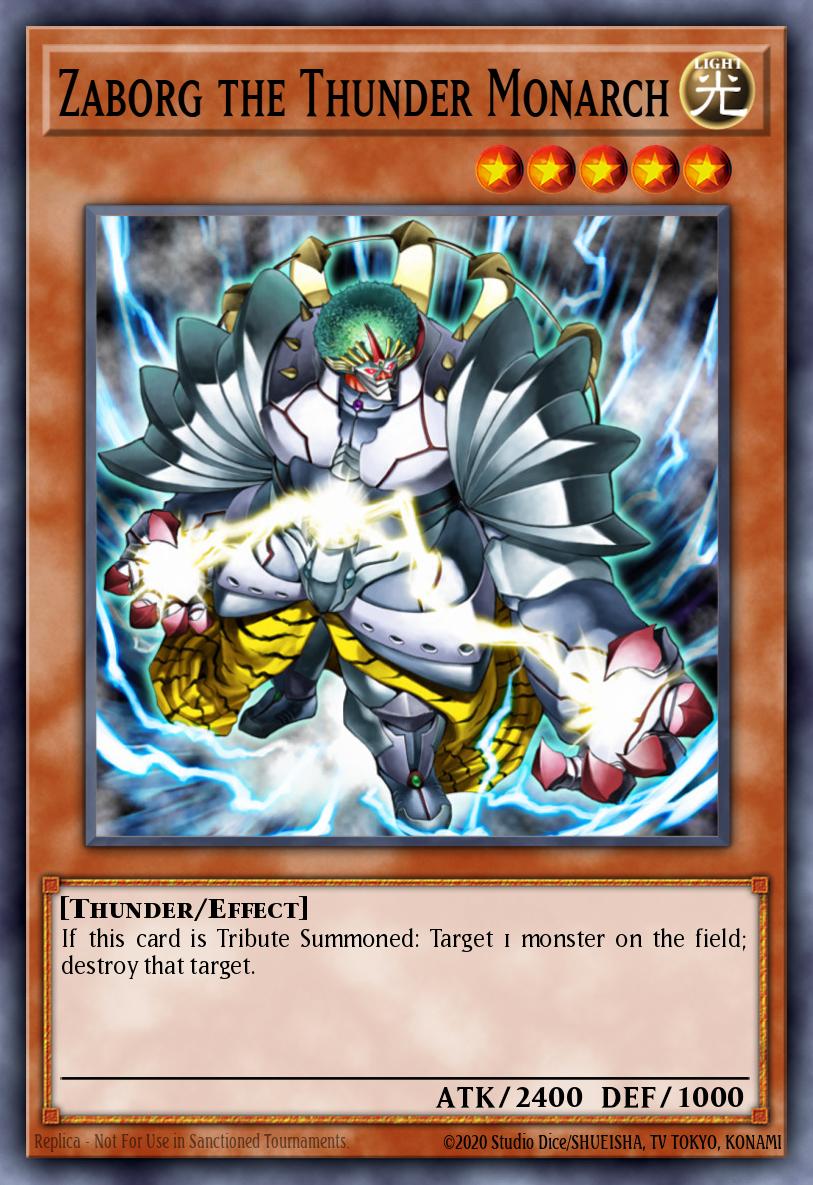 Zaborg
ZaborgThe last thing of note during this format was the fate of Warrior Toolbox. While the engine had dominated the October 2005 Forbidden List meta, the limiting of D.D. Assailant had definitely put the brakes on the deck's rulership of the meta. The engine would survive, albeit in a reduced and less popular form. The new version of the Warrior Toolbox now consisted of a single copy each of D.D. Warrior Lady, D.D. Assailant, Exiled Force, Don Zaloog, and depending on the build, Blade Knight and/or Mystic Swordsman LV2. These monsters were usually coupled with a single copy of Reinforcement of the Army, although some builds did still opt to run 2 copies. While the strength of Warriors as an engine had definitely waned, they had not really lost in popularity overall as a deck. A much more dedicated Warrior variant rose up in the April 2006 format referred to as Rat Box. The Rat Box version of the deck often strayed away from Chaos elements and focused more on EARTH-Attribute Warriors to win games. This variant focused on utilizing Giant Rat to toolbox out various different Earth Warriors in a very similar manner to how Tomato Control used Mystic Tomato to summon out a variety of Dark monsters. While Rat Box saw relatively wide usage at the locals level, it never quite made a serious impact on the meta during 2006, only managing to get one SJC top 8.
The 2006 Chaos Return format finally ended with a September Forbidden List which made Chaos Sorcerer Forbidden. This Forbidden List was particularly notable because it marked the Chaos Return format as a shorter format due to the changing of the dates of when Forbidden and Limited Lists would be released in the TCG. Previously, they were released every 6 months in April and October. However, the September 2006 Forbidden List marked a shift to them being released in March and September in order to better align with when the Forbidden Lists were released over in the OCG. This list also saw Spirit Reaper get Limited, a card that had seen essential staple status almost unbroken since the end of Goat Format.
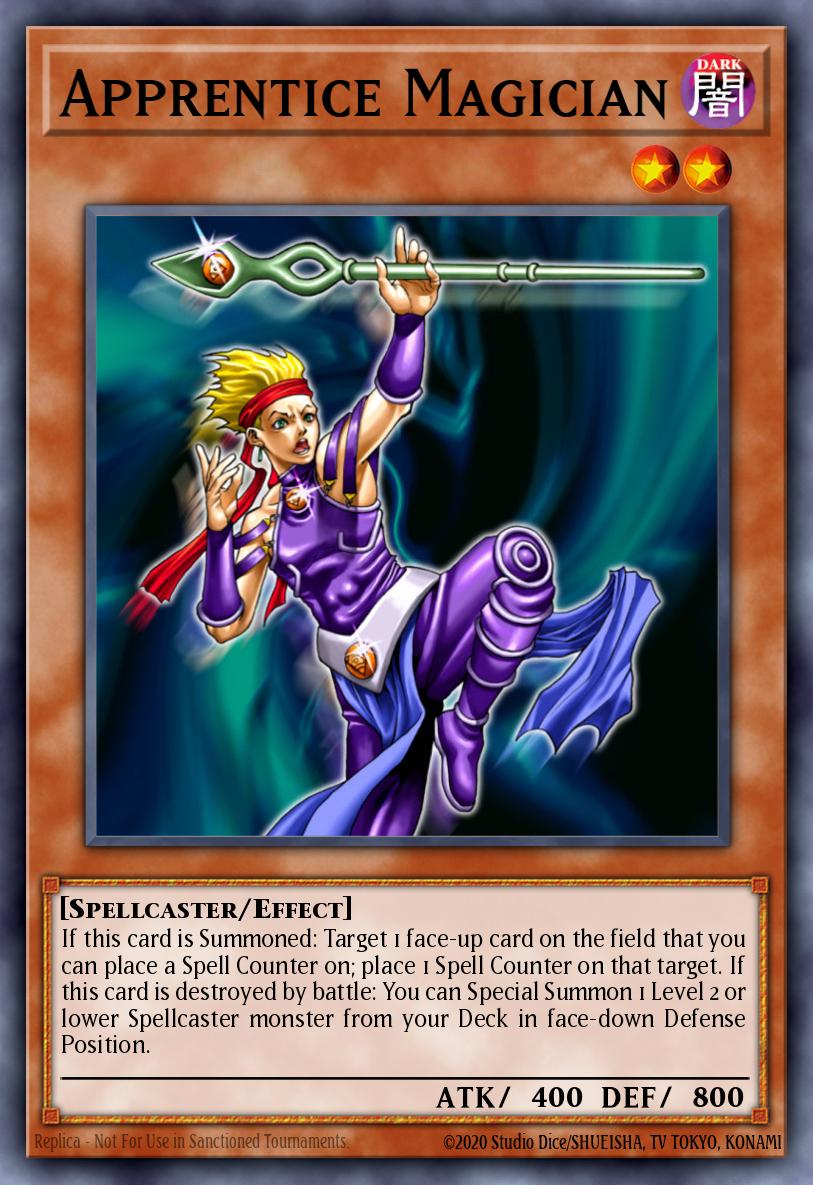 Apprentice Magician
Apprentice MagicianThe new format that emerged from this list had itself squarely centered around what was now easily one of the most powerful cards left in the TCG: Cyber-Stein. While Cyber-Stein had been seeing widespread usage before the September 2006 List, afterwards Monarch Control took over the top dog in the meta and by extension the Zaborg/Last Will combo became more and more dominant. Now that Monarchs had finally risen to the top of the meta, a few further changes started to appear in the way the deck was built. These changes were mainly pioneered by Lazaro Bellido, who got top 8 at SJC Boston near the beginning of the format and Ryan Spicer at SJC Austin soon after. This new variant of Monarchs, dubbed Lazaro/Spicer Monarchs, rethought some of how Monarchs had previously been built. While before Monarchs had largely been focused on using battle traps in order to protect Flip monsters, now the deck was focused much more on utilizing a large number of Floaters for tribute fodder. These Floaters included the Apprentice Magician engine as well as Mystic Tomato in order to complement the already run Treeborn Frog. These decks also switched their Monarch lineups to be much more aggressive. While before Monarch players would run 3-5 Monarchs, usually some mix of Zaborg and Mobius, Lazaro and Spicer switched over to aggressively running 2-3 copies of Zaborg and Thestalos. This caused the deck to have a much higher power output as well put much more raw pressure on an opponent. The new iteration of Monarch Control also took great advantage of 3 Spell cards that had seen variable usage up to this format, but had never been used as part of a coordinated strategy: Creature Swap, Brain Control, and Soul Exchange. Creature Swap was an extremely powerful card due to its ability to give an opponent a floater such as Treeborn Frog or Mystic Tomato and then destroy that monster without having to wait a full turn. This would allow the deck to move at a much faster pace and generate much faster field advantage. Brain Control and Soul Exchange both served to help get additional tribute fodder for the Monarch monsters while also serving as a form of removal for an opponent's monsters, clearing them away to summon a player's own powerful Monarch monsters. The other common engine that got played during this period, most notably by SJC Boston winner Bobby Chambers, was Gravekeepr's Spy. Graekeeper's Spy was put in decks to fill a very similar purpose to Apprentice Magician, providing a floater to the deck. However, Gravekeeper's Spy was a somewhat popular alternative due to its much higher DEF making it possible for the monster to survive a turn in addition to floating into a new copy of itself.
These decks also made a common habit of using a transformative Stein OTK side deck. Even more so than before, Lazaro/Spicer Monarch decks would run the key engine pieces of Stein OTK in their side deck and switch to them in later games. This is one of the first notable competitive occurrences of so-called "smokescreen" strategies, where a player runs one deck, but can switch their core strategy in later games of the match by using their side deck.
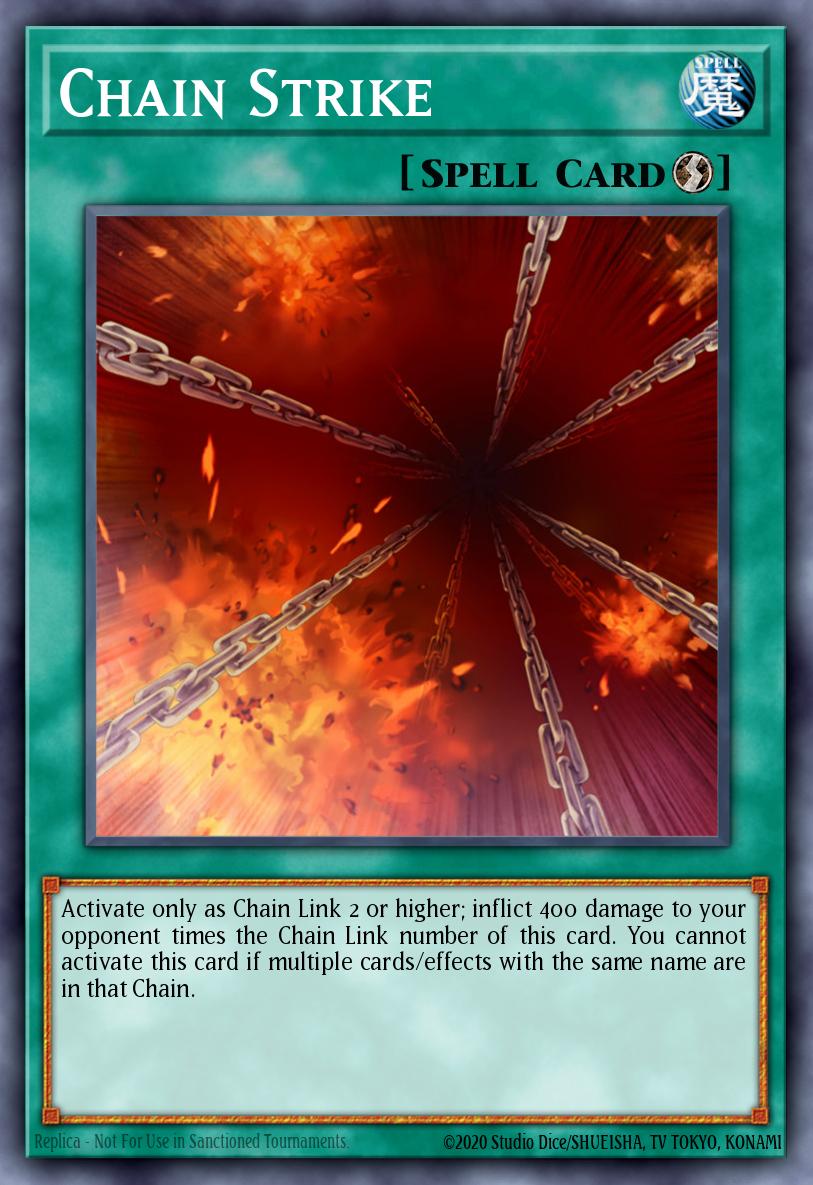 Chain Strike
Chain StrikeThe new Lazaro/Spicer Monarchs would continue to dominate the large events of the format until mid-November when a new booster set, Cyberdark Impact, was released. This set introduced a new burn card called Chain Strike which became the basis of a new deck known as Chain Burn. The deck was a much more powerful variant of the Stall/Burn decks that had been around in the competitive scene since Goat Format. While it didn’t diverge too much from its predecessors, it did use Accumulated Fortune, Jar of Greed, and other such generic draw cards to considerably boost its consistency, such that it didn't have to rely on lengthy stall strategies and could instead focus on quickly drawing into the combo pieces it needed to win. The rise in prevalence of Chain Burn would both weaken the potency of Stein OTK strategies by quickly depleting their Life Points to the point where Stein couldn't use its effect while also not playing into the battle dependent nature of Lazaro/Spicer Monarchs as Chain Burn didn't play very many monsters.
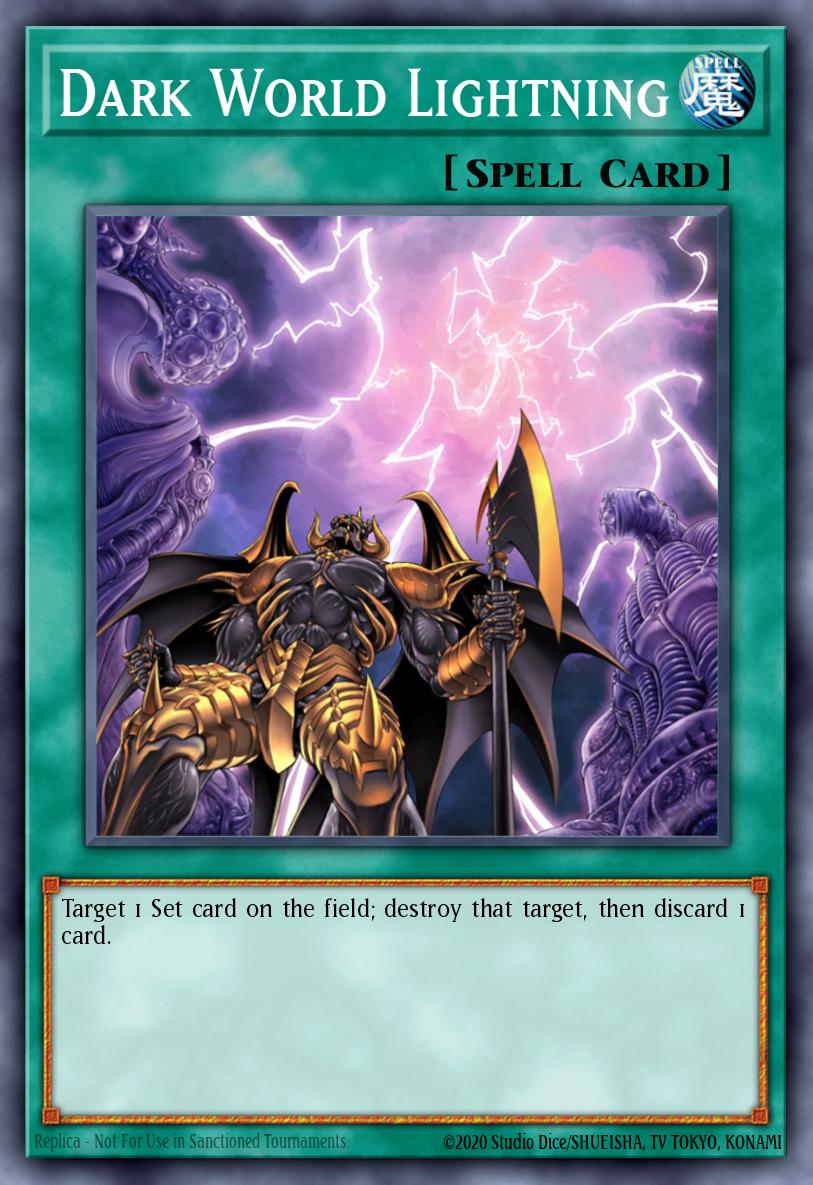 Dark World Lightning
Dark World LightningThe last deck that started to gain some traction in this format was Dark World. Dark World at the time was a relatively small archetype focused around monsters that would Special Summon themselves when discarded from the hand. This became a particularly potent meta call with the advent of Lazaro/Spicer Monarchs due to that deck's common usage of Thestalos to discard from an opponent's hand, on top of the already common use of Confiscation as a staple Spell Card in many decks. In addition to serving as a meta call to the rise in discard effects, Dark World decks also had access to Dark World Lightning which could both remove an opponent's backrow, something that was still somewhat limited due to all of the key backrow removal Spells being Limited or Forbidden, and also trigger the summons of Dark World monsters. Finally, Dark World decks had the ability to use Deck Devastation Virus which could very easily destroy an opponent's ability to build up a field presence with their smaller monsters such as Apprentice Magician and Spirit Reaper.
Although the end of 2006 had served as the first Monarch dominated format, it was decidedly more dominated by the extreme power of Cyber-Stein. To this end, Cyber-Stein was moved from Unlimited to Forbidden in December as part of the first true "Emergency Banlist" in the TCG. Cyber-Stein would get one more spin before being locked away for good, taking first place at SJC San Jose, the last high level event of 2006.
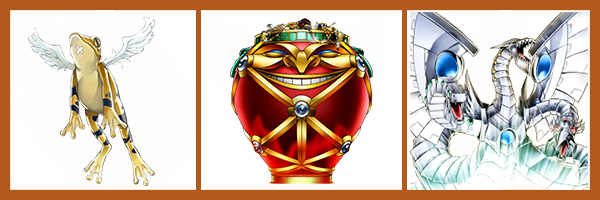 Treeborn Frog, Jar of Greed, Cyber End Dragon
Treeborn Frog, Jar of Greed, Cyber End Dragon2007
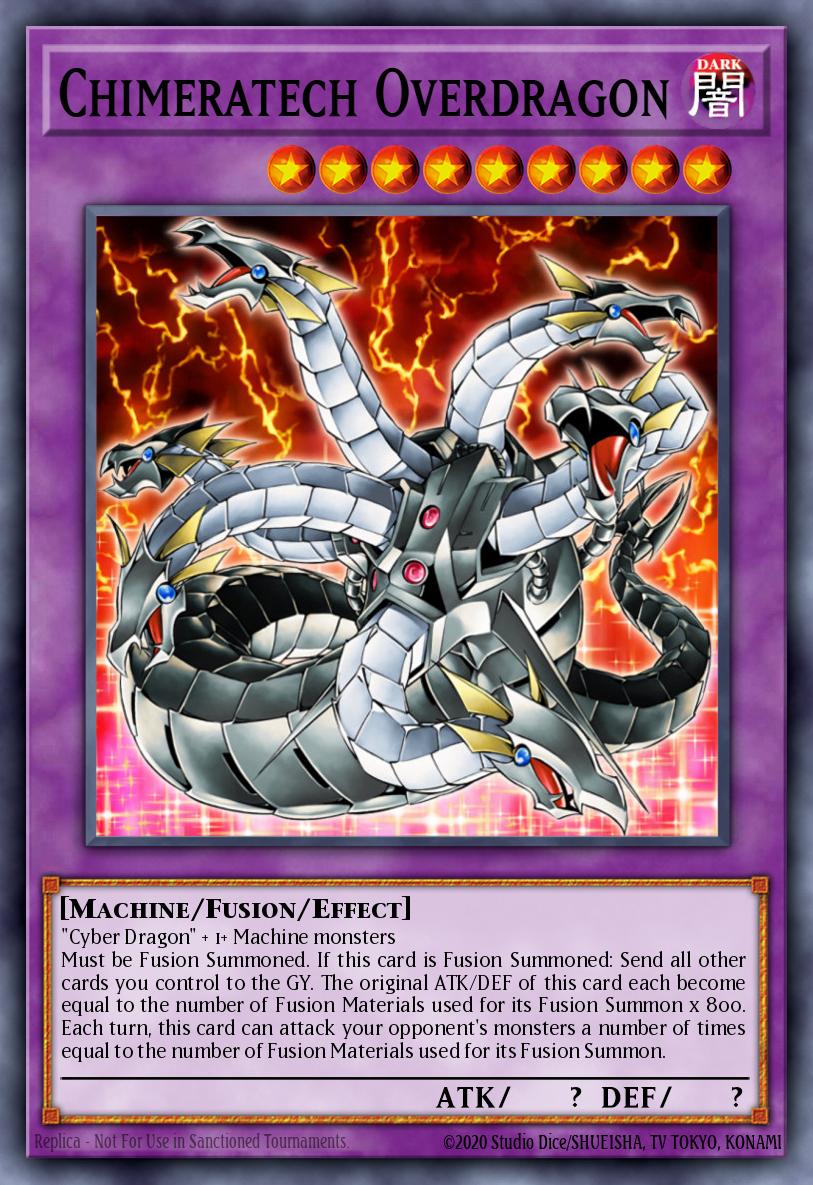 Chimeratech Overdragon
Chimeratech OverdragonWith Cyber-Stein now Forbidden, players had started looking for new ways to to exploit powerful OTK strategies. The deck that they found utilized several cards that had been released in 2006 but hadn't seen much use then due to being overshadowed by Cyber-Stein and Chaos Sorcerer. The deck that would come into the meta was a new extension of older Machine Beatdown decks from the classic era of the game. This new version focused on using two new and very powerful Spells, Future Fusion and Overload Fusion, to easily Summon out a Chimeratech Overdragon with absolutely massive ATK. This earned the variant the name of Chimeratech OTK (though it was also known as Cybertech or just Cyber due to the large number of Cyber monsters that were played in it). The main focus on the deck was drawing into the two card combo of Future Fusion, which would send any number of Machine-type monsters from the deck to the Graveyard, and then Overload Fusion to use those Machines in the Graveyard to summon Chimeratech Overdragon. Unlike most decks at the time which used a lot of battle traps and other such cards to control a game's tempo, Chimeratech OTK was much more focused and generally ran mostly traps that allowed the player to draw such as Jar of Greed or Reckless Greed. The deck also ran a large number of cards that would wipe the board clan of Spells and Traps to ensure that all of the attacks from Chimeratech Overdragon would go through.
Although Chimeratech OTK would go on to dominate the top spots at SJC Orlando in January of 2007, Monarch Control still managed to maintain a foothold using similar tactics to what the deck had employed before the Emergency Banlist. Another new deck also appeared during this format: Gadgets. Gadgets were released in the TCG in the Machine Re-Volt Structure Deck, an Ancient Gear Structure Deck released in mid-January. Although they were relatively simple cards, the Gadget monsters would immediately be seen for their great potential in allowing a deck to maintain card advantage over time. The early iterations of the deck that saw success were dedicated Gadget decks focused around maintaining card advantage with the Gadget monsters and then exploiting that card advantage through Snipe Hunter which could utilize the Gadgets for discard fodder. The deck also made good use of Ultimate Offering to continuously summon out Gadgets and flood the field and then clear out the opponent's monsters using a large number of monster removal spells such as Fissure, Hammer Shot, and Smashing Ground along with the standard removal battle traps.
The final mix-up to this early 2007 format was the introduction of 3 more meta-defining new cards in February: Destiny Hero Malicious, Card Trooper, and Elemental Hero Stratos. Card Trooper wouldn't really catch on in the competitive scene immediately and it mostly saw use as a tech in Chimeratech OTK decks upon its release. Malicious and Stratos, on the other hand, would combine together into a very potent new deck that would go on to absolutely dominate the format in some form or another for months to come: Airblade Turbo, later called Diamond Dude Turbo. The Airblade Turbo version of the deck focused on using the 3 legal copies of Monster Gate and Reasoning to fill the Graveyard with Warrior-Type monsters which could then be banished in large quantities by Divine Sword Phoenix Blade. The banished monsters could then be summoned back all at once using Dimension Fusion, allowing for easy OTKs. The deck would prove to be extremely consistent due to the wide variety of draw-power cards such as Destiny Draw and Graceful Charity in combination with the 3 copies of Elemental Hero Stratos which could search all relevant monsters.
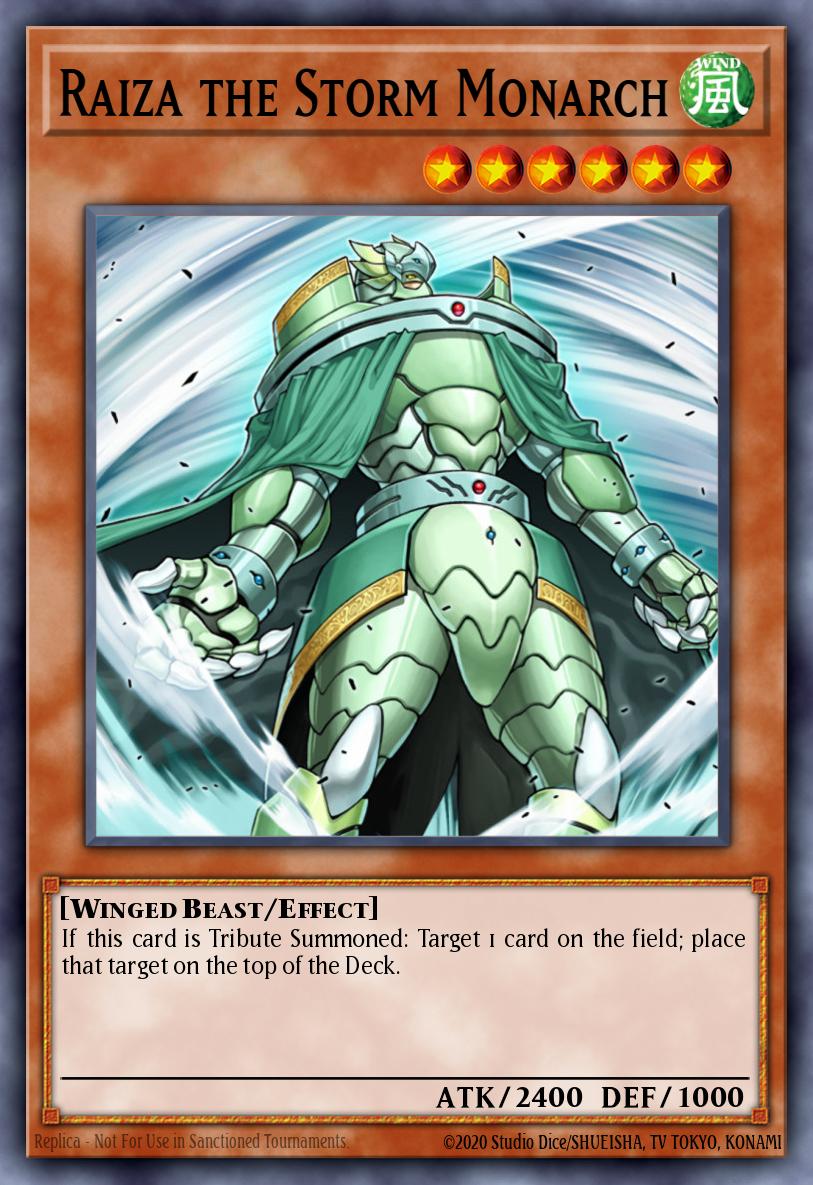 Raiza the Storm Monarch
Raiza the Storm MonarchThis small format ended with the March 2007 Forbidden List. The Limiting of Overload Fusion killed Chimeratech OTK, the Forbidding of Cyber-Stein eliminated Stein OTK, the Limiting of Chain Strike neutered Chain Burn, and the Forbidding of Graceful Charity shunted Dark World from the meta. Elemental Hero Stratos was also Limited to stop Airblade Turbo less than 2 weeks after it hadbecome legal to play in the TCG. The main surviving decks were Monarchs and the remains of Airblade Turbo, now just called Diamond Dude Turbo. Monarch Control would continue using a similar philosophy that had brought it to victory in the Lazaro/Spicer format of late 2006, but now with more up to date cards. The Apprentice Magician engine had become abandoned in favor of a combination of Gravekeeper's Spy for floating and Legendary Jujitsu Master to make attacking into face-down defense position monsters dangerous. Outside of the new floaters, Monarchs had also adopted 2 to 3 copies each of Soul Exchange and Brain Control as standard. All of these together lead to a variant of Monarchs establishing itself that many people refer to today as Soul Control Monarchs. Monarchs received further support in May of 2007 with the release of Raiza the Storm Monarch in Force of the Breaker. Raiza was a particularly powerful card, as it offered non-destruction and non-banishing removal, making it much more difficult to recover from, card-advantage-wise, as monsters could not be "revived" from the Deck. Due to their continued power and the introduction of Raiza, the Soul Control Monarch deck was able to establish itself with the most tops of the format. This wasn't by a very wide margin, however, and the deck certainly was not unbeatable.
The remainder of the meta was split between several different decks: Destiny Hero variants, Card Trooper Variants, Gadgets, and Demise OTK.
In the wake of Elemental HERO Stratos being Limited, Diamond Dude Turbo became the dominant variant of Destiny Heroes. The deck relied on the extreme card advantage generation of Destiny HERO monsters, especially the eponymous Destiny HERO - Diamond Dude. Because of the easy searching provided by Elemental HERO Stratos and Reinforcement of the Army, Diamond Dude Turbo established itself as one of the first major meta decks that rose to prominence based largely on its consistency rather than its power. The deck also made great use of Destiny HERO - Disk Commander's effect using Premature Burial, alongside Dark Magician of Chaos which could very easily recycle it. Dark Magician of Chaos also had very good synergy with both Dimension Fusion and Metamorphosis, making it much easier for the deck to finish opponents off. Diamond Dude Turbo still made use of Reasoning, Monster Gate, and Magical Stone Excavation as well to easily reach the deck's many Spell cards. Destiny Heroes also saw some usage in mid-2007 as an engine in other decks, most notably in Monarchs, a combination that would be a precursor to the later format of 2007.
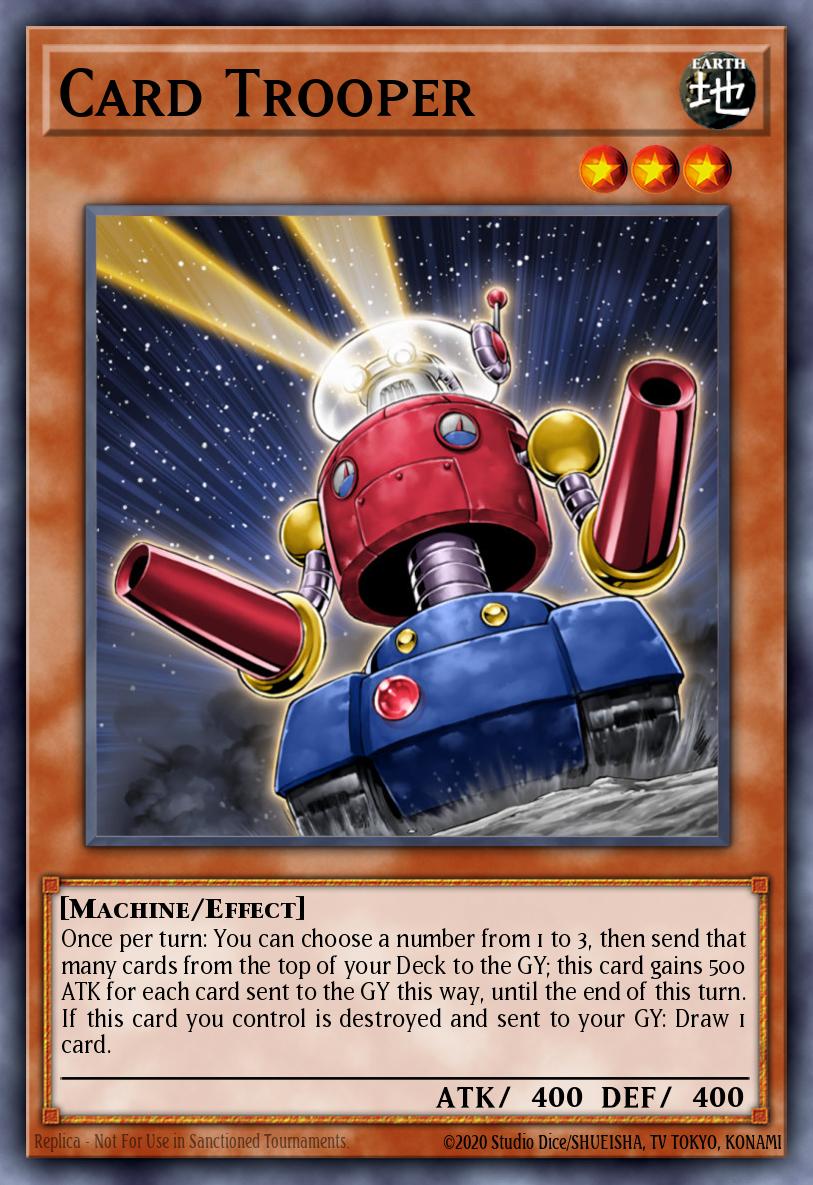 Card Trooper
Card TrooperDecks based of another new card, Card Trooper, also came into prominence around this time. The first real deck to exploit this was Bazoo Trooper, an updated variant of the Bazoo Return deck from 2005. The new variant focused on using Bazoo the Soul Eater to banish the monsters milled by Card Trooper in order to make huge plays with Return from the Different Dimension. This variant of the deck would prove to be far too slow for the meta as the format started to shape up, only really making an impact in the first SJC of the format in March of 2007. The top players soon discovered a new combo that would shape how Card Trooper would get played. This new combo was called the Troop Dupe Scoop combo, in which players would use Machine Duplication on Card Trooper to summon 2 additional Card Troopers from the deck. These Card Troopers could then each mill 3 cards, raising them all to 1900 ATK, after which Limiter Removal would allow for an OTK. The Troop Dupe Scoop combo was relatively easy to add into a deck and as such was usually played in Machine Beatdown style decks that used cards that had commonly been seen before in the Chimeratech OTK decks from the beginning of the year such as Cyber Phoenix.
The other major deck of note from this format was Demise OTK, a deck that used the Ritual Monster known as Demise, King of Armageddon, along with Doom Dozer and Megamorph, to clear an opponent’s field and attack for 8000 damage in one turn. The combo involved using Advanced Ritual Art to send 2 Insect-Type monsters from the Deck to the Graveyard in order to Ritual summon Demise. Then, Demise could pay 2000 Life Points to clear the field, and the two Insects used to summon him could be banished from the Graveyard to summon Doom Dozer. Demise's effect cost would allow players to them use Megamorph to double one of their monsters' ATK, leading to an exact OTK.
The overall picture of the meta in mid-2007 was generally even, with no deck absolutely dominating the format for what seemed like the first time in the game's history. Instead, a field of several decks could all compete simultaneously, a state of the game that hinted as to the general direction the meta would tend towards in the future.
With the September 2007 Forbidden List, the meta shifted again as Card Trooper and Megamorph were Limited, effectively eliminating the more dedicated Card Trooper decks and the various different OTK decks that relied on Megamorph such as Demise OTK. The list also Semi-Limited Destiny HERO - Malicious and Limited Destiny HERO - Disk Commander, making it much more difficult for pure Destiny HERO decks to stay afloat in the meta. Metamorphosis was also Forbidden on this list, taking a large portion of Diamond Dude Turbo’s OTK potential with it. Even Monarchs got an indirect hit in the form of Brain Control being Limited. Finally, the Gadgets were all Semi-Limited to reign the Gadget deck in.
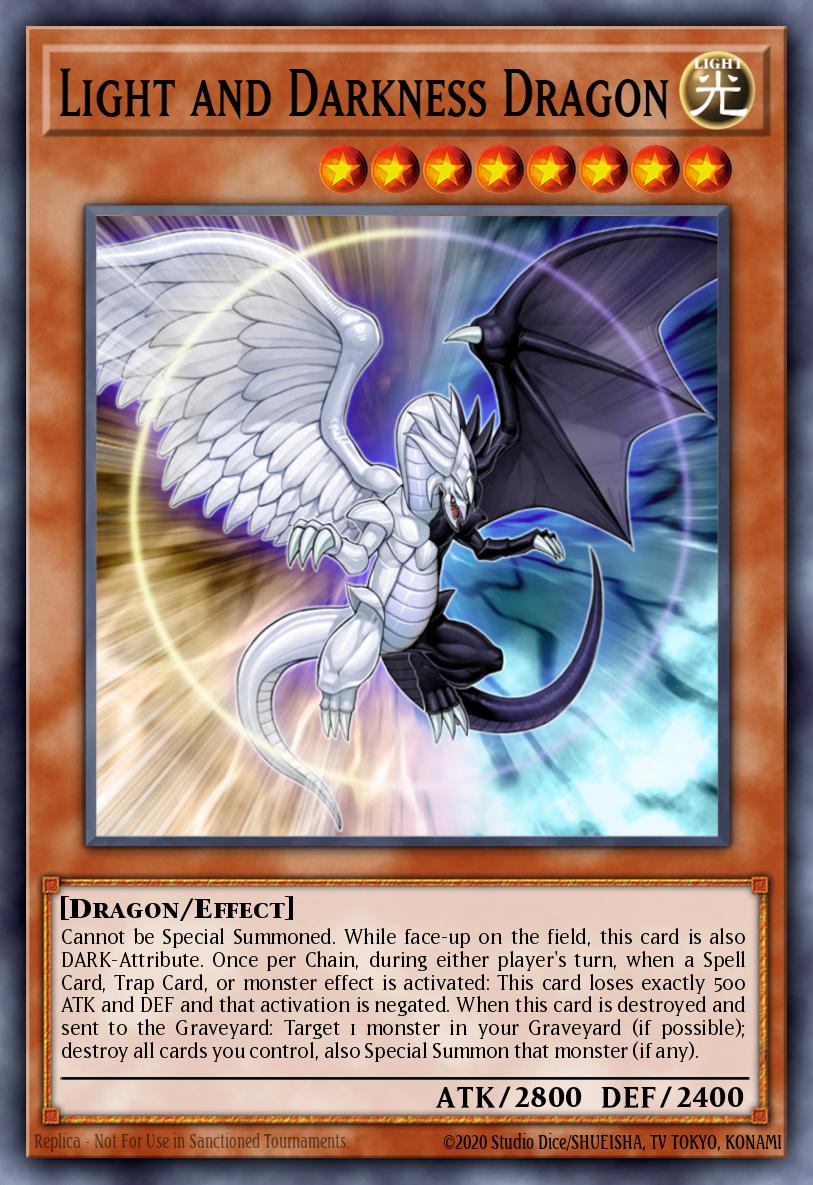 Light and Darkness Dragon
Light and Darkness DragonWith their individual engines stripped of their former power and consistency, Diamond Dude Turbo and Monarchs could no longer stand alone in the meta. However, this did not mean they could not combine into a single deck that would take advantage of the remains of both engines: Perfect Circle Monarchs. This deck utilized the Destiny HERO draw engine and Destiny HERO - Malicious for easy Tributes to make for easier Tribute Summoning of the Monarch monsters. Perfect Circle Monarchs also made use of a card that came out in late 2007: Light and Darkness Dragon. Light and Darkness Dragon served as a boss monster for the deck, something which it lacked after the loss of Metamorphosis. While the Monarch monsters were very powerful, they only had powerful effects when they were Summoned, making them easier to take care of after that. Light and Darkness Dragon's effect, however, gave most other decks a very difficult time. To top it all off, Light and Darkness Dragon would Special Summon another monster after being destroyed, making so that even after opponents got over it, its controller would maintain some card advantage.
Another major deck of this format was a resurgent Zombie deck which functioned very similarly to Zombie decks from Goat Format, utilizing strategies involving Book of Life and Pyramid Turtle. The main additions to the deck were Zombie Master and Il Blud, which gave the deck the ability to more easily access the Graveyard while also providing a new boss monster to replace the power-creeped Vampire Lord. These new revival cards also let Zombies use an old card that hadn’t before seen much space in the competitive scene: Card of Safe Return. With Zombie Master, Book of Life, and Premature Burial, Zombies could frequently trigger Card of Safe Return to gain massive card advantage. The deck made a significant showing at the first SJC of the format, but dropped off after that due to the general trend of Graveyard hate.
This Graveyard hate was exemplified no better than by the newly popular D.D. decks. These were focused entirely on the D.D. cards, specifically D.D. Scout Plane and D.D. Survivor, in combination with continuous Spells and
Stall decks also caught on in the meta at this point. An ever-present force, these decks were initially too slow with their limited burn options to go in for the kill, while later on, decks would prove too fast and outpace their stall engines. Stall made a resurgence at this point due largely to the slew of newer, powerful Trap Cards that could control the game, while also using some new monsters. Neo Spacian Grand Mole was released earlier in 2007 and could remove any monster from the from the field without having to destroy it, and without letting its own controller take damage. The main card that brought stall decks into the meta, however, was Marshmallon, as it was only removable through card effects at a time when the main source of effect removal was in Tribute monsters such as Raiza, or battle traps that Marshmallon would never trigger. Marshmallon also dealt 1000 points of damage when it was flipped face-up, making it a formidable burn card for slower decks.
It must be noted, however, that while all of these decks managed to get some scattered tops at regionals, and showings at Shonen Jump Championships, the format remained largely dominated by Perfect Circle Monarchs.
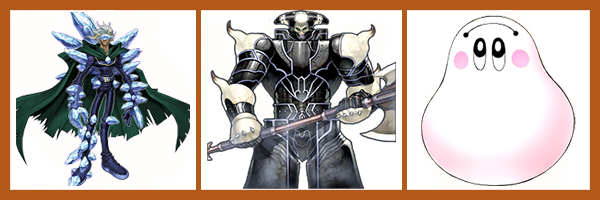 DH Diamond Dude, Demise, Marshmallon
DH Diamond Dude, Demise, Marshmallon2008
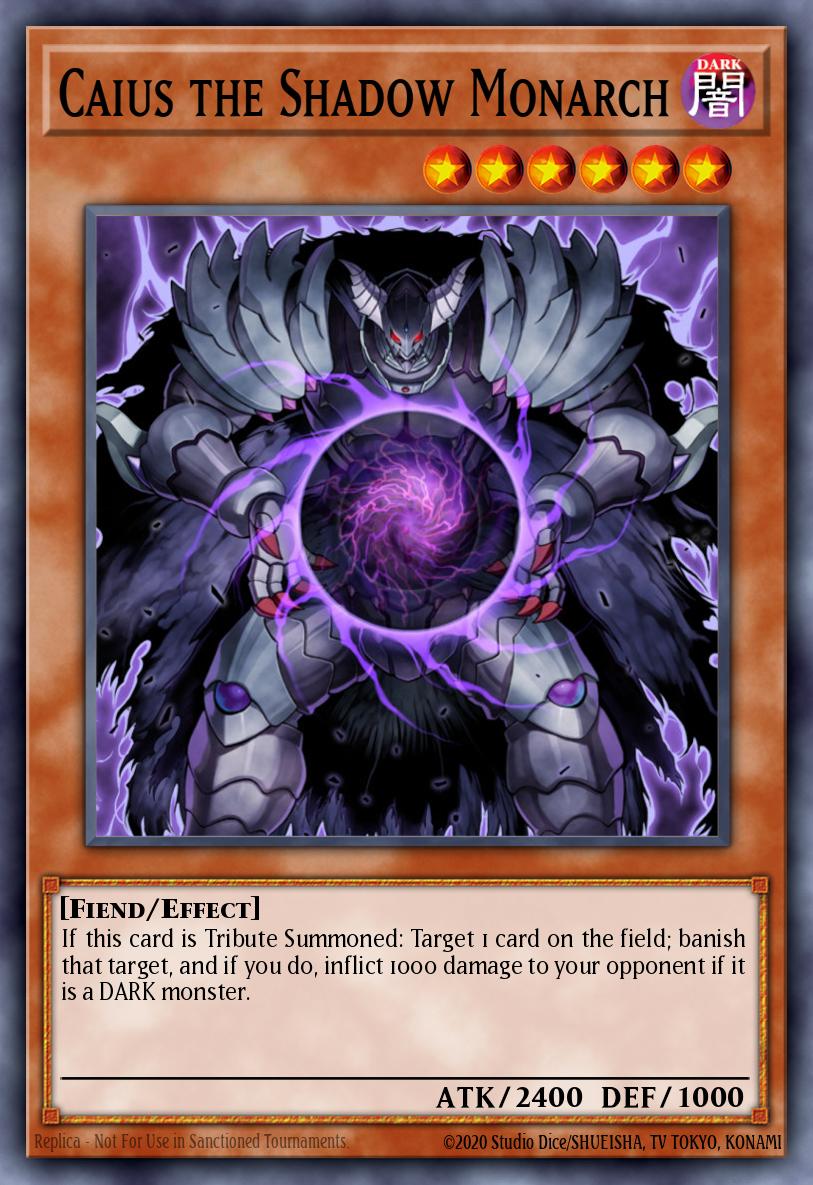 Caius the Shadow Monarch
Caius the Shadow MonarchThe beginning of this year saw the continuation of the late 2007 meta with Perfect Circle Monarchs being dominant, but Zombies and Burn took a backseat to Gadgets. Perfect Circle Monarchs had gotten a boost in early 2008 with the release of Caius the Shadow Monarch which, along with Raiza the Storm Monarch, served to replace the old monarchs such as Thestalos and Zaborg. The introduction of Caius and his ability to banish any card made him the perfect counter to both Zombies and Stall, with Zombies relying on their monsters going to the Graveyard and Stall relying on the opponent not being able to get past their various defensive cards. Gadgets, on the other hand, served as the anti-meta to Perfect Circle Monarch’s meta. While Perfect Circle was largely reliant on utilizing the Graveyard, Anti-Meta Gadgets focused on maintaining card advantage and using cards such as Banisher of Radiance, Dimensional Fissure, and Macro Cosmos to prevent the opponent from using the Graveyard. This strategy was particularly powerful against Perfect Circle because of how much the Destiny Hero engine and Light and Darkness Dragon relied on going to the Graveyard to be fully effective.
The next format shift of 2008 was sparked by the introduction of a new booster set, Phantom Darkness. This format was the infamous DAD format. The first form that the deck took was Return DAD. The deck focused on the titular DAD, or Dark Armed Dragon, and the powerful Dark Attribute focused support that was released in the Phantom Darkness booster set. Some of this support included Allure of Darkness, Dark Grepher, Armageddon Knight, and Darklord Zerato which was then also used alongside the already popular Destiny Hero engine. The deck relied on getting DAD out as fast as possible to control the board which was extremely easy considering how much draw power the deck had with Destiny Draw, Allure of Darkness, and Destiny Hero Disk Commander. The deck would then be able to easily OTK the opponent by using Return from the Different Dimension to summon back all of the banished Dark monsters that had been used to fuel DAD’s effect. The first SJC that the deck was legal for saw positive results for it, but Dark Armed Return didn't utterly dominate the event, with Six Samurai actually taking 1st place. The deck would take over more definitively with the March 2008 Forbidden List which Limited Raiza the Storm Monarch and Semi-Limited Light and Darkness Dragon, two hits that crippled the main core of the Perfect Circle Monarch deck. Because of the elimination of Perfect Circle and the severe gap in consistency and power between Return DAD and Gadgets, Return DAD was left as the only deck in the competitive meta. The only other decks that managed to maintain a foothold in this format were Six Samurai and Kaiba Control.
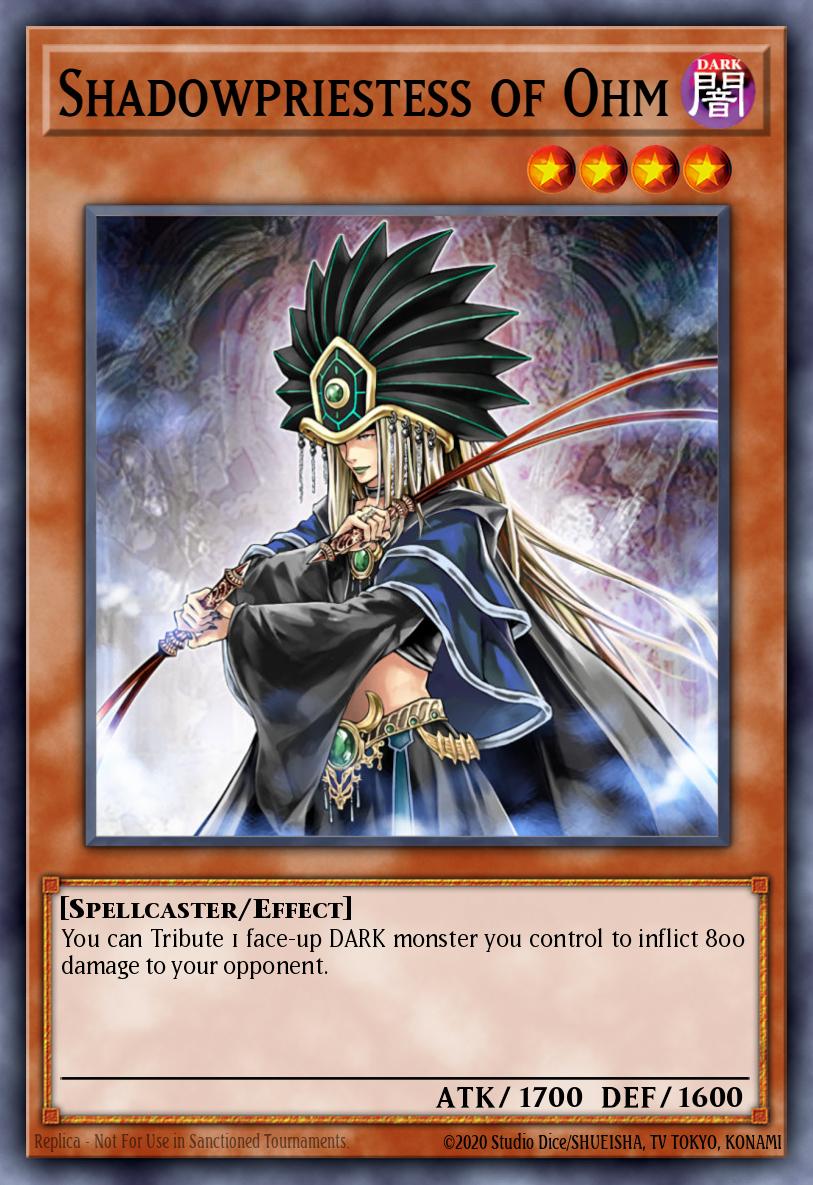 Shadowpriestess of Ohm
Shadowpriestess of OhmSix Samurai as a deck was largely played more at the local level. However, it did see two successful tops at larger events due to the deck’s ability to both flood the field and have a variety of answers to different situations. In this way, the deck was not entirely dissimilar to the Warrior Toolbox deck from 2006, except with more consistency. The other deck from this format, Kaiba Control, was a combo OTK deck. The combo revolved around using a combination of Shadowpriestess of Ohm, Dimension Fusion, Spell Economics, and Dark Magician of Chaos. The combo was focused around getting both Dark Magician of Chaos and Shadowpriestess out on the field at the same time. Shadowpriestess could then tribute Dark Magician of Chaos to burn the opponent, causing Dark Magician of Chaos to be banished. Dimension Fusion would then be used to summon it back to the field and Spell Economics would bypass the Life Point cost of Dimension Fusion, allowing it be used continuously. The final piece of the combo was Dark Magician of Chaos’ effect recycling the Dimension Fusion, allowing the loop to be established.
However, this only lasted until the release of Light of Destruction 2 months later. This booster set introduced the first two fully competitive archetypes to the TCG: Gladiator Beasts and Lightsworn. Technically Gladiator Beasts had been released in 2007, but they didn’t receive the support to make them competitive until the release of Gladiator Beast Gyzarus in Light of Destruction. Lightsworn also presented a significant threat in the meta because of the sheer power of Judgment Dragon. Judgment Dragon served as a much easier monster to get out than Demise, while also having 3000 ATK, making it stronger than all of the other boss monsters in the meta at the time, including Dark Armed Dragon. Judgment Dragon allowed Lightsworn to compete against the dominance of Dark Armed Dragon as a boss monster while Gladiator Beasts had good survivability and consistency that allowed them to outlast Return DAD.
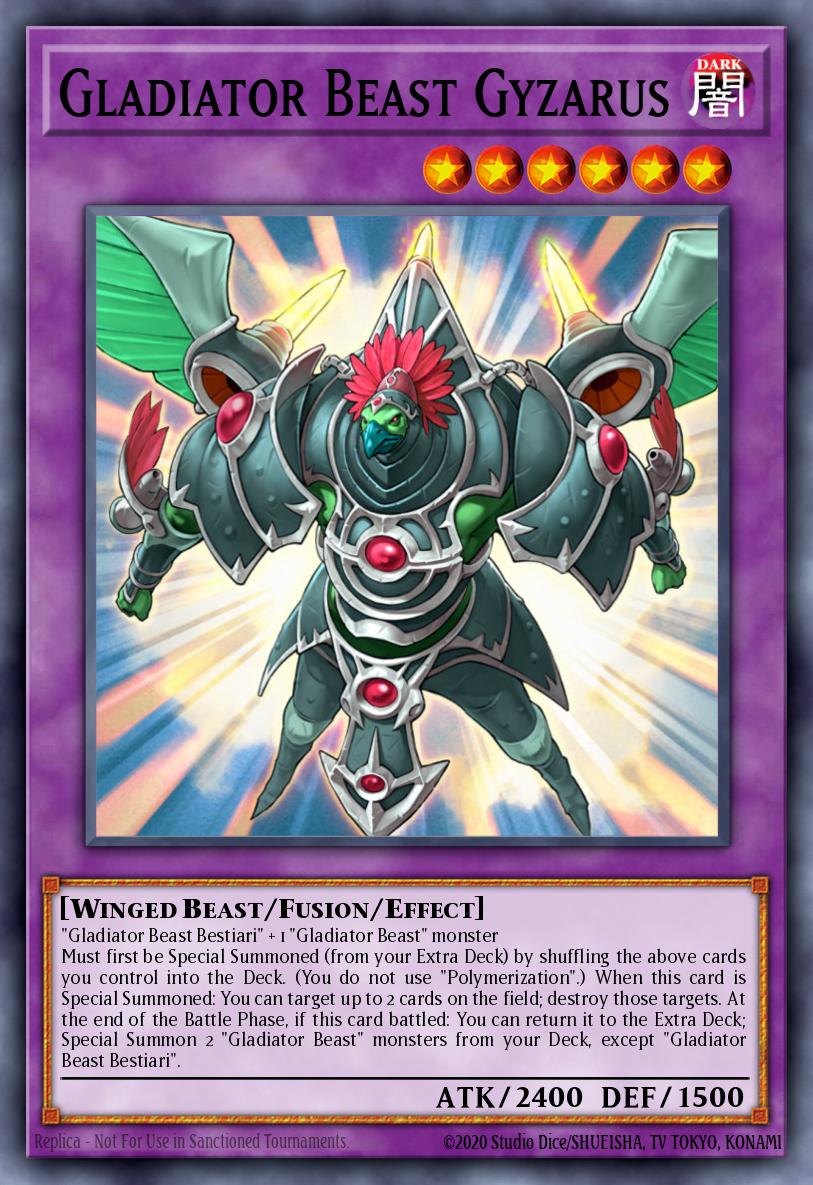 Gladiator Beast Gyzarus
Gladiator Beast GyzarusBecause of the consistency and staying power of Gladiator Beasts, they ended up splitting the top of the meta with Return DAD, leaving Lightsworn as a minor contender in the meta. The deck had been released in Gladiator’s Assault in late 2007, but Light of Destruction gave the deck Gladiator Beast Gyzarus, a fusion that was able to destroy multiple cards on the board with its effect on summon. Because of the multi-targeting nature of the card, its generic use, and the ease with which it could be repeatedly summoned, Gyzarus made Gladiator Beasts a formidable deck. An emergency Forbidden List was also released in May of 2008, addressing the extreme consistency of the Kaiba Control combo and the dominance of Return DAD. In this list, the only changes were Dimension Fusion being Forbidden, Return from the Different Dimension being Limited, and Allure of Darkness being Semi-Limited. The resulting meta now converged around Gladiator Beasts which would prove themselves as the strongest deck in the meta against Lightsworn and a weakened Return DAD. Gladiator Beasts would show this by consistently winning the next 6 Shonen Jump Championships.
This would all get upended with the release of a brand new summoning mechanic: Synchro Summoning. Synchro Summoning was released with the August 2008 booster set The Duelist Genesis to coincide with the new anime, Yu-Gi-Oh! 5D’s. The new mechanic allowed for a new type of main deck monsters, called tuners, to be used with other monsters by adding their levels together in order to summon powerful Synchro Monsters from the newly rebranded Extra Deck, previously called the Fusion Deck. However, at this point, the pool of available Synchro Monsters was very small and there were not a very wide pool of available tuners with which to make these Synchro monsters. In spite of this, The Dark Armed Dragon deck would quickly adapt to the new mechanic, shifting into the infamous Tele-DAD variant of the deck.
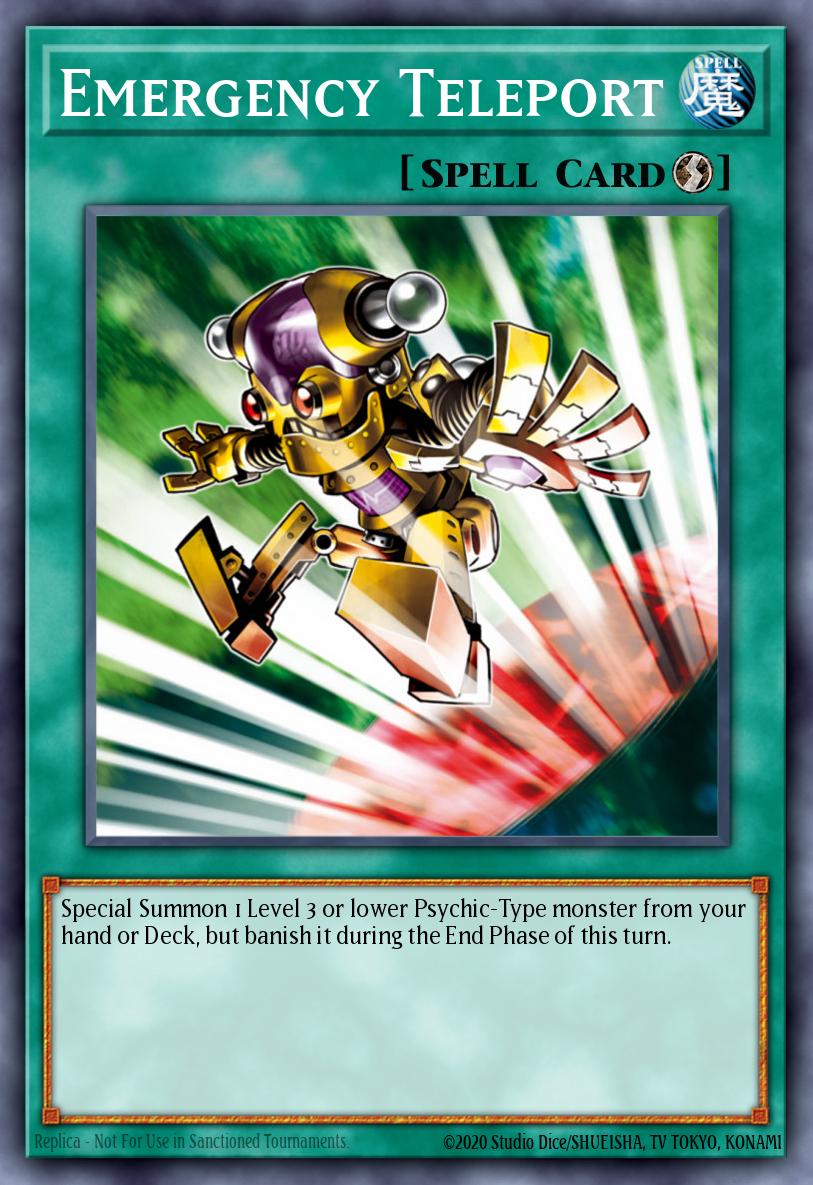 Emergency Teleport
Emergency TeleportTele-DAD was a variant of the Return DAD deck that added in the Destiny Hero engine and Krebons to enable easy Synchro plays. The teleport portion came in with Emergency Teleport which was used to special summon Krebons from the deck, making Synchro plays very easy to perform. Gladiator Beasts continued to get tops throughout September, especially at SJC Baltimore, the first large event after the release of Synchros and the September 2008 Forbidden List. Although DAD was Semi-Limited in this list along with Disk Commander, Premature Burial, and Dark Magician of Chaos being Forbidden, the force of Synchros would prove to be too strong. Tele-DAD didn't end up winning the first event it was legal for, that honor instead going once again to Gladiator Beasts, but the new form of the deck still managed to take over half of the top 16 spots. After this, the meta soon started to solidify around Tele-DAD as the best deck. While Lightsworn, Gladiator Beast, and a new version of Zombies that used Synchros managed to sneak in sparse tops during this format, Tele-DAD was undoubtedly the top deck through the rest of 2008. The new deck out of these, Zombie Synchro, was a variant of the popular Tele-DAD deck combined with parts of the Zombie deck that had been in the meta in late 2007. This variant of the deck focused on utilizing Plaguespreader Zombie, a Zombie type tuner monster that could Special Summon itself from the Graveyard, in conjunction with Card of Safe Return (which had been Limited in the September 2008 List) and Burial from the Different Dimension. It also took advantage of two new Zombie support cards that had been released in Phantom Darkness, Mezuki and Goblin Zombie. Mezuki was the more prominent of the two, allowing for even further Graveyard revival than the deck already was capable of. Although the deck was largely the same as Tele-DAD, it could arguably generate more card advantage due to the easy looping power of Zombies and the drawpower of Card of Safe Return.
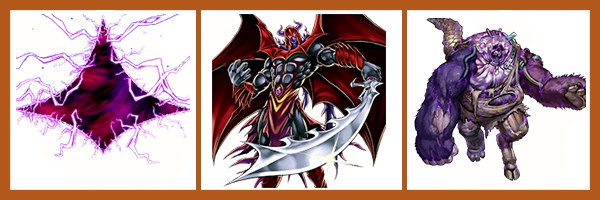 Dimensional Fissure, Darklord Zerato, Plaguespreader Zombie
Dimensional Fissure, Darklord Zerato, Plaguespreader Zombie2009
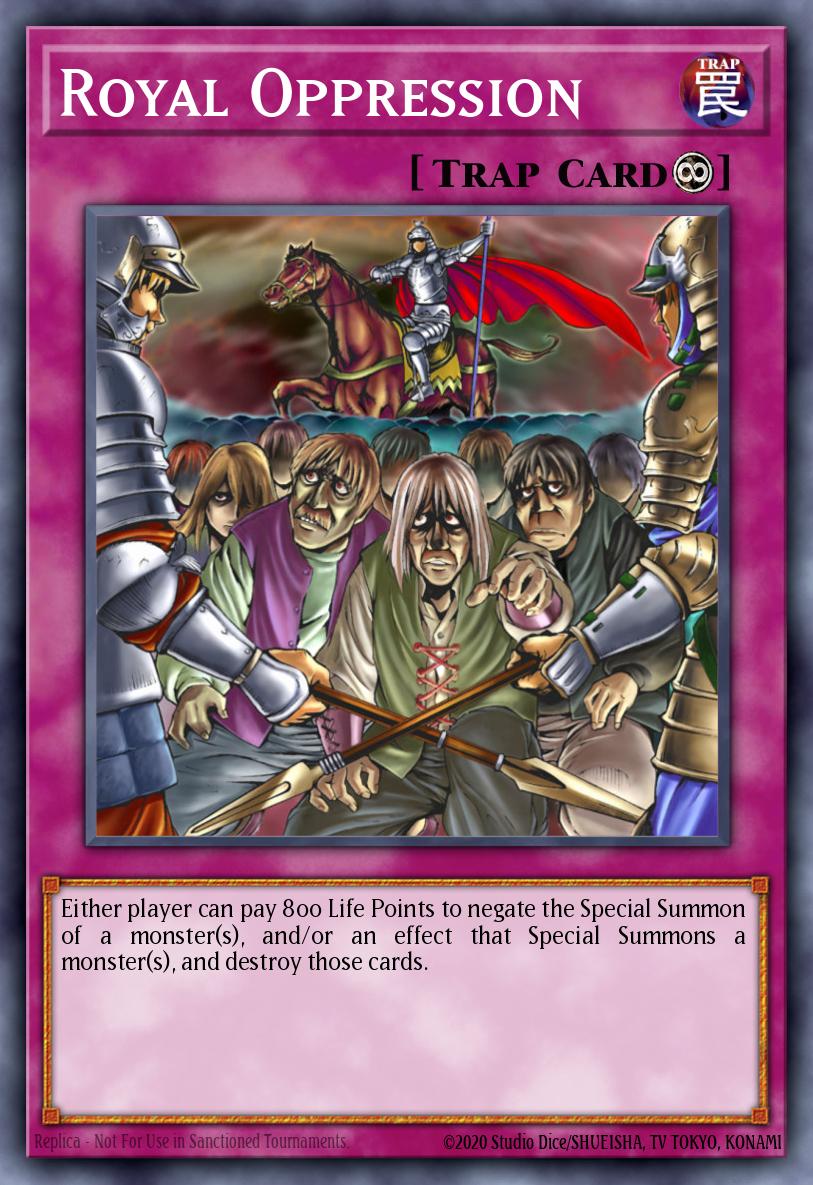 Royal Oppression
Royal OppressionThe beginning of 2009 saw the continued dominance of Tele-DAD, but the only Shonen Jump Championship at the beginning of the year was SJC Houston 2009, also known as the Forgotten Shonen Jump. It earned this name because Upper Deck Entertainment, the original distributors of Yu-Gi-Oh! in the TCG were in legal proceedings with Konami during this time. The legal proceedings were over Upper Deck having distributed counterfeit cards to a 3rd party company. Because of this turn of events, Konami sought to repossess the game’s distribution from Upper Deck. This tournament was most notable for both having very little coverage among the common metagame reports of the time and also for introducing a new card into the maindeck staple set: Royal Oppression. Royal Oppression had been an extremely common side deck card since Special Summoning had become a more prevalent mechanic back in the early GX era, but it had never been commonly ran in the maindeck before this point. SJC Houston 2009 saw more than half of the top 16 decklists running at least 1 copy, sometimes even 2, of Royal Oppression in the maindeck. This was primarily because of a shift in how the game would be played. Due to the sheer power level of boards that could be established by a deck such as Tele-DAD, being able to reinforce that board by locking the opponent out of being able to do the same made Royal Oppression something of a capstone for many powerful fields. The lawsuit ended in the early spring of 2009 and ownership of the Yu-Gi-Oh! TCG was transferred to Konami, meaning Konami would from here on control the game worldwide. Along with this change came a somewhat radical shift in prizing for tournaments, with Konami generally giving less prizes than Upper Deck Entertainment did. By the time the competitive scene resumed as normal, the March 2009 Forbidden List had been released which saw Dark Armed Dragon, Emergency Teleport, Gladiator Beast Bestiari, and Goyo Guardian all limited with Destiny Draw, Destiny Hero Malicious, and Allure of Darkness all being semi-limited.
This Forbidden List completely neutered almost every part of the Tele-DAD deck, excising it from the meta entirely. The deck lost its consistency with the hits to Emergency Teleport, Allure of Darkness, and Destiny Draw, as well as its ability to repeatedly and easily generate advantage with the use of Destiny Hero Malicious as well as losing its main two power plays of having multiple Dark Armed Dragon on the board at once and using Goyo Guardian to easily control the game. The exit of Dark Armed Dragon centered decks from the meta allowed Synchro to truly take hold in the competitive scene as its own thing and not just an extension of the previous era of the game. This shift in both of the ownership for the TCG and the general meta would mark a change in the tides for Yu-Gi-Oh!, being the point where the “New Yu-Gi-Oh!” is said to have started. This “New Yu-Gi-Oh!” would be a much faster game, focused around summoning monsters out of the Extra Deck, and using intentionally designed archetypes of cards instead of cobbling together a variety of generic good cards. The game would also start to see a surge in new players during this time period, with many players getting into the game during this period and causing the seeds of the present Yu-Gi-Oh! Community to start to form.




